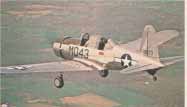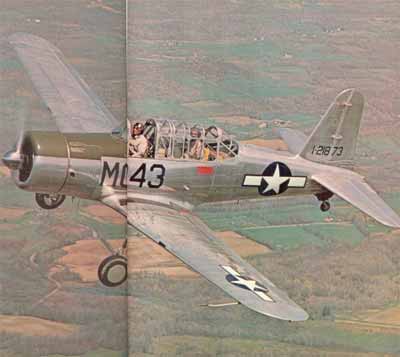Bill Riddle's BT-13A Isn't an airplane,
it's a 450-hp ticket to the past. Almost every visit to an airport
brings out at least one member of the I-trained-in-BT-Its club. Few
graduates of WWII flight schools, Navy or Air Force, escaped the clutches
of the Vullee BT-13/SNV. When I first saw M043, all dressed up in its
WW-II Luke Field markings, I too had a sudden attack of nostalgia,
but mine had nothing to do with World War II- Some 24 years ago, my
father paid $4W for a surplus BT, had the name of our store painted
on the side, and towed it around local county fairs for the kids to
sit in. I wonder if the distinctly military smell of this leaky old
aluminum school marm infected other boys the same way it did me.
As I climbed into Bill Riddle's airplane, I was suddenly back playing
fighter pilot in the vacant lot next to our house, in what I thought
was the greatest airplane in the world. 1 wonder where USAAF 35467 is
now?
BT stands for basic trainer, and as such it tell midway between the P
for primary of the PT-17s, 19s and 26s, and the A of the AT-6 Texan advanced
trainer. The BT-13 was the airplane that introduced a generation of pilots
to constant-speed props (although some had two-position propellers only),
manifold pressure and lots of horsepower with matching noise.
As originally designed, the BF-13 was part of a litter—it had three
brothers. Vultee decided that rather than design one airplane, they'd
design an entire family, trainer to fighter. The primary trainer was
to be the B-541, the advanced trainer with retracting gear
was the B-54, a combat trainer was the BC-51 and the single-seat fighter
was the P-48. All these designs died in infancy except the P-48, which
was produced in small numbers for foreign governments, and
for the USAAF as the P-66. The B-541 survived to become the BT-13 for
the USAAF and the SNV for the Navv.
The idea behind this related design effort was to produce airplanes that
used common components, but still gave the performance needed for different
roles. The center sections and tails were the same on several
of the models, and all wings were built in basically the same jigs. This
is why the lumbering BT-13 has a nearly symmetrical airfoil, something
a fighter needs, but which a trainer certainly could do without.
As with most military trainers, the BT-13 was built to take the beating
it was going to get from ham-handed students. The complete cockpit section,
engine to tail cone, is a tubing trusswork that's almost guaranteed to
protect the pilots hiding inside. A derrick-like rollover structure
sticks up between the cockpits.
 |
Although the lines are significantly
different, the BT-13 still gets mistake for an AT-6 sometimes. |
A number of BTs were cranked out with plywood tailcones
and empennages. These may have been the result of wartime shortages,
and many pilots speak of looking up into the rearview mirror during
a snap roll to see the entire tail section lagging behind the rest
of the airplane by several degrees. This usually cured them from doing
snap rolls. Another characteristic that discouraged snaps was the way
the wing fuel tanks needed only the slightest excuse to start leaking.
Most BT-13s had the well-known Pratt & Whitney R-985. Apparently,
however, there was some sort of delivery hangup with this 450-hp coffee
grinder because a variant of the BT-13 was equipped with the 420-hp
Wright R-975. These Wright-powered Vultees were redesignated BT-15s.
Bill Riddle's airplane couldn't look better if it had been built yesterday—or
even this morning. Most wartime trainers bear the scars of
many students stomping up the wing walk and trying to throw their heavy
flight boots over the cockpit side, but missing. M043 is unscarred because
it was never truly a trainer. According to the records researched by
Riddle, his BT-13 was the personal ship of the commander of
a training squadron. Apparently, the airplane spent more time being polished
than flown—and it certainly looks it.
Riddle tries to make people understand that his airplane has never
been restored—it was never allowed to get run down in the first place.
Since its discharge in 1945, it has always been somebody's Sunday afternoon
plaything. Bill says the only problem he has with the airplane, wherever
he goes, is that everybody thinks it's a T-6—a mistake easily
made.
GO TO NEXT PAGE
|

